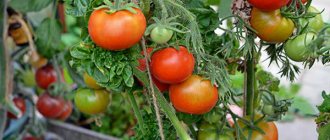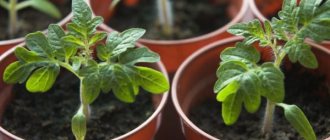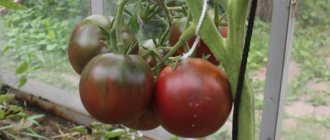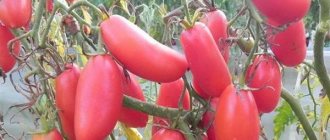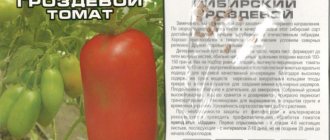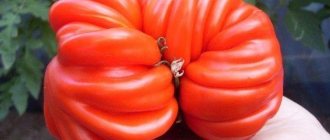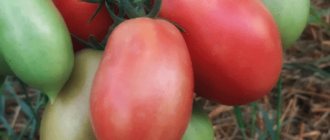A large-fruited, mid-season tomato variety, unpretentious and high-yielding, which was developed relatively recently, but has already become popular among Russian vegetable growers.
Each vegetable grower has his own criteria for choosing the varieties and hybrids of tomatoes that they plan to grow in their garden beds or in greenhouse conditions. Some people want to grow vegetable plants with small cherry-type fruits, while others want to see tomatoes with an original shape or color of fruit in their garden. But large-fruited tomatoes are always popular among summer residents, the fleshy fruits of which can not only be used for preparing salads, but also for preparing various winter preparations - ketchup, tomato paste, juices, etc.
One of these varieties is the Pudovik tomato, the very name of which speaks about the shape of its fruit. The main characteristics, nuances of cultivation, reviews, photos of the variety will be presented below.
Description
The Pudovik tomato was bred at the beginning of this century by private breeders V. N. Dederko and O. V. Postnikova. The tomato was introduced to the Russian State Register in 2005. After this, the Pudovik tomato was undergoing variety testing for two years, and only in 2007 was it included in the State Register of Agricultural Achievements.
The tomato, according to the description in the State Register, is intended for growing in garden beds and under film covers. The originator of the variety and the manufacturer of seed material is currently the agricultural company Siberian Garden.
Description of the bushes
Pudovik tomato bushes are determinate, so their growth is limited to the formation of an inflorescence with ovaries at the top. The height of plants can be up to 1.4-1.5 m. The bushes grow powerful, strong and spreading.
The shoots are also strong and tall, with medium foliage, but require garter, as they can bend and break under the weight of ripening large fruits. The foliage is typical of a tomato variety, medium in size, with narrow tips, slightly wrinkled leaf blades, a slight gloss and a rich emerald color.
Description of fruits
The Pudovik tomato is distinguished by an average period of fruit ripening - about 110 days pass from the moment of germination of the seed material to the harvesting of ripe fruits.
The ripe fruits of the Pudovik tomato have a large heart-shaped shape with slight ribbing on the sides. The weight of ripe fruits is 500-700 g, but when the bushes are formed into a pair of shoots, the first fruits weighing more than 1.3-1.4 kg can be grown.
The skin is of medium thickness, susceptible to cracking when there is high soil or air humidity - during the rainy season. The color of the glossy skin is red with a crimson tint.
The pulp of these tomatoes is of medium density, with 4 seed chambers and a sufficient number of seeds. The color of the pulp is crimson-red.
Important! Some unscrupulous traders may sell Sto Pudov tomato seeds instead of Pudovik tomato seeds. But the last variety has a slightly flattened pear-shaped tomato shape, the color of the smooth skin is deep red, there are up to 5-6 seed chambers inside, and their average weight is about 300 g.
Pudovik tomatoes have a pleasant salad taste - moderately sweet with a slight sourness. Tasters gave the fruits of this tomato the highest rating - 5 points out of 5 possible; they claim that the composition of Pudovik tomatoes perfectly combines sugars and acids.
The collected fruits should be transported carefully, as they are very large and can crush each other during transportation. But ripe Pudovik tomatoes can be stored in the refrigerator for up to several weeks without losing their pleasant taste and beautiful shape.
Due to the excellent taste of the fruits, they are classified as salad fruits, therefore they are used primarily for adding to summer salads and other snacks. But many housewives make delicious lecho, ketchup and tomato juice from fleshy tomatoes.
Description of the appearance of the bush and tomato fruits
The bush is medium high. Reaches 1–1.4 meters. If weather conditions or care are unsuitable, the height may be less than 100 cm. This often happens in open ground. In greenhouses, gardeners can achieve maximum height.
Expert opinion
Stanislav Pavlovich
Gardener with 17 years of experience and our expert
Ask a Question
The branches are spreading, there are many of them. But the stem itself is not strong enough. Therefore, the gardener must maintain it and periodically tie it up. The leaves are dark green. From a distance they resemble potatoes.
Characteristics of Pudovik tomato
The Pudovik tomato has good resistance to temporary drops in temperature, and the variety is also undemanding and unpretentious, so vegetable growers do not have much trouble growing this tomato.
Advantages and disadvantages
The main advantages of the Pudovik tomato include:
- Tomato bushes do not require special care:
- high yield;
- large fruit;
- excellent taste of ripe tomatoes;
- versatility of the harvested crop;
- the possibility of long-term storage of tomatoes after harvesting;
- good resistance of Pudovik tomato bushes to various diseases.
The main disadvantage of this tomato is the tendency of the fruit to crack.
However, if you do not allow excessive soil moisture during watering, then this can be avoided. Also, due to the large size of the fruits, it is necessary to form bushes and tie the shoots to strong supports.
Productivity
To achieve high yields from these tomatoes, you should follow the irrigation regime and regularly apply fertilizer. It is also recommended to form bushes with 2-3 stems, in this case the size of the fruits will be larger. Then from each bush you can collect at least 5 kg of tasty large fruits.
Growing region
The variety was bred specifically for cultivation in the difficult climatic conditions of the Urals and Siberia. But despite the fairly high resistance to changes in air temperature, in these regions it is recommended to grow the Pudovik tomato in film greenhouses or greenhouses.
Resistance to diseases and pests
This vegetable plant is characterized by fairly high resistance to most diseases characteristic of other tomato varieties.
And many vegetable growers say that with regular application of all the necessary fertilizers to the garden beds, the tomato bushes do not get sick throughout the summer season.
Pros and cons of the variety
| Advantages | Flaws |
| has a long fruiting period | when pressed hard, dents remain and cannot be stored for a long time |
| excellent taste properties | thin skin |
| the fruits are well preserved, so the variety is of commercial interest | requires gartering and removal of stepsons |
| characterized by increased sweetness | |
| high yields |
Planting and care
The Pudovik tomato is grown in seedlings, then you can get a harvest from this vegetable plant earlier. To ensure high tomato yields, you need to start by growing high-quality seedlings. To do this, you need viable seed material, a nutritious loose substrate and good lighting of the seedlings during growth.
Sowing time
It is necessary to plant the seeds of this tomato at the same time as the seed material of most other varieties of tomatoes, about a couple of months before the intended transplantation of the seedlings to a permanent place.
Since these plants in most regions are planted in greenhouses or film greenhouses around the end of April, Pudovik tomato seeds for seedlings can be sown already in the last ten days of February.
When growing this garden crop in open ground, the seedlings are transplanted in the second ten days of May, so in this case it is necessary to plant seed material at home in the second ten days of March.
The soil
Usually, to grow tomato seedlings, a special nutrient substrate intended for growing vegetable seedlings is purchased in specialized stores.
But many vegetable growers prefer to prepare the soil for planting seedlings themselves. At the same time, they prepare a soil mixture with a composition approximately the same as in garden beds, on which the grown seedlings will subsequently grow.
To prepare such a nutritious substrate, summer residents usually mix turf, high peat and humus in equal proportions. To make it looser, you can add river sand or rotted sawdust to the prepared mixture.
Before putting home-prepared soil mixture into containers, it must be disinfected. This is done because pathogenic microorganisms or larvae of harmful insects can hide in the components of the substrate for the winter. To destroy them, you need to calcine the soil in the oven - it is heated to 180ᵒC and the soil mixture is placed inside. It needs to be heated for 30 minutes.
Important! After calcination, the soil must be allowed to cool. Only after this can it be laid out in containers and seed material planted.
Growing containers
Containers for growing tomato seedlings should be wide and long enough, and the height of the sides should be no more than 5 cm.
Even if these containers have not previously been used for growing seedlings of any cultivated plants, the containers must be disinfected before pouring soil into them.
To do this, they are washed with a weak solution of potassium permanganate, dried and filled with a nutrient substrate.
Seed preparation
Seed material that was purchased at a gardening store does not require pre-sowing preparation, since all the necessary procedures were carried out by the agricultural company that produced the seeds.
But those seeds that were harvested from their ripe fruits should first be checked for germination. To do this, they are lowered into a glass of water and all the seed material that floats to the surface is thrown away, since it will be empty inside. All seeds that have sunk to the bottom are taken out and soaked for half an hour in a weak solution of potassium permanganate for disinfection. Then they are washed and placed in a growth accelerator solution for a short time, dried and planted in prepared containers.
Sowing seeds
Seeds are laid out in rows on the surface of the soil in containers, making the distance between them up to 2 cm, and the distance between rows up to 3 cm. The soil in the containers is pre-moistened. Then the seeds are sprinkled on top with a thin layer of soil and again moistened with a spray bottle.
But you can simply bury the seed material into the soil 1-1.5 cm and water it with a spray bottle so that the seeds are not washed out.
The containers are covered with polyethylene on top to create a greenhouse effect inside. In this case, seedlings will appear faster.
Important! Containers with seed material should be kept in a warm place with an air temperature of about +25ᵒC until numerous shoots appear. This usually happens after 6-7 days.
Seedling care
After friendly sprouts have appeared, the film must be removed from the containers and the plants themselves must be moved to a bright place. It is better if these are window sills facing the south or southwest side.
In the first days, the sprouts need to be hardened; for this, the temperature in the room is reduced to +18ᵒC, but then it is raised again to +22+23ᵒC.
Subsequently, the plants are watered as the top layer of soil dries. Watering is done strictly at the root with warm water.
When several permanent leaves appear on the seedlings, they should be picked into separate cups. The sprouts should be replanted with a clod of earth so that the delicate roots are not damaged.
During the period of growing seedlings, they are fed twice with an interval of 10-14 days. For the first time, seedlings need to be fed with urea two weeks after the picking procedure. The next feeding should be done no later than two weeks before transplanting the plants to a permanent place. You can use any fertilizer containing nitrogen as a fertilizer.
Hardening of seedlings
Pudovik tomato seedlings are hardened off so that they quickly get used to new growing conditions after transplantation.
First, you should take the seedlings of this tomato outside for no more than an hour. But gradually the time outside for them is increased, leaving the seedlings outside and overnight in the last days before transplanting.
Planting seedlings in a permanent place
Although the bushes of this tomato do not grow too tall, they are too spreading. Therefore, no more than 4 plants are planted on each square of area.
The soil on the site is prepared in advance - in the fall. To do this, all remnants of vegetation are removed, organic fertilizer is added, and digging is done using a shovel. When digging, organic matter should be embedded in the soil so that it does not wash out when the snow melts.
The holes are dug immediately before planting the seedlings; a handful of wood flour and the same amount of potassium salt should be placed on their bottom, and a layer of soil on top. Then one seedling is placed in each hole along with a lump of earth, sprinkled with nutrient substrate on top. It should be compacted and then watered.
Important! To prevent moisture from evaporating from the holes too quickly, the root zone of the plants is mulched with a layer of straw or humus.
How to grow
Pudovik seeds are sown for seedlings from late February to March in nutritious and universal soil. In order for the plant to grow stronger and gain strength, it needs at least 70 days before picking. Shoots appear within a week after sowing in pre-prepared soil.
Growing seedlings
When two true leaves appear, the plants are transplanted into individual containers. In order for the seedlings to stretch, the best place for their growth will be a bright, southern window. The optimal temperature during the day is no higher than 20°C, and at night – no more than 16°C. Such conditions will make the seedlings compact.
To prevent it from outgrowing, various techniques and technologies are used:
- lower the temperature and increase the light;
- trim the root system;
- treat with a growth reduction drug.
On a note. The plant is transplanted into open ground when return frosts no longer occur. The “age” of the seedlings by this time should be at least 60-70 days.
Transplantation into the ground
Any place for replanting the plant is not suitable. The site must meet the following indicators:
- the predecessors of the crop should not be nightshades;
- It is better to choose a soil that is light and breathable;
- the place must be protected from strong winds;
- be sunny;
- without stagnation of moisture.
If the plant was grown in individual containers, then picking is easy. Carefully, without damaging the roots, remove the seedlings along with the soil from the cups and place them in the soil (in pre-made holes) up to the leaves.
If the seedlings are too elongated, which often happens with tall varieties, they can be planted lying down or the stem bent.
On a note. Before planting seedlings in the ground, it is recommended not to water the plant so that it is more pliable, and after planting, the sprouts will begin to absorb moisture and grow roots from the shoot sites, which will be sprinkled with soil.
Features of outdoor care
Further care for the Pudovik tomato consists of observing the watering regime, regular fertilizing, forming and tying up bushes, loosening the soil and removing weeds.
Watering
Watering is carried out in this way. so that the soil is moist, but not waterlogged, otherwise the fruits will crack. Water for irrigation should be warm and settled. It is important that when watering, drops of moisture do not fall on the leaf blades and stems - then the plants may begin to rot.
Top dressing
In order for the fruits to grow large, one should not forget about regular feeding. The Pudovik tomato responds well to the application of mineral fertilizers. After transplantation, you can add nitrogen-containing fertilizers to the soil to activate the growth of the vegetative mass. From the moment the buds appear, the Pudovik tomato is fed with superphosphate and potassium salts, which accelerate the appearance of numerous ovaries and also improve the taste of ripening tomatoes.
Forming and tying a bush
Typically, the bushes of this tomato are formed into 2-3 stems when growing 3 plants on one square area. If you plan to plant the Pudovik tomato more densely, then you need to form its bushes into only one stem.
Since tomatoes grow large, the shoots as they grow are tied to strong pegs, otherwise the stems may break or fall to the ground.
Soil care
The root zone around the Pudovik tomato bushes should be loosened after each watering or rain. This procedure helps remove dry crust from the surface of the earth and improves the penetration of oxygen to the roots of plants.
You should also regularly remove all weeds from the tomato beds.
Diseases and pests
The Pudovik tomato is highly resistant to diseases and pest attacks, which makes caring for these plants easier.
Disease and pest control
Experienced vegetable growers who grow this tomato regularly say that it is enough to constantly apply mineral fertilizers to it throughout the season. In this case, the plants’ immunity increases and they are not affected by any pathogenic microorganisms. Also, harmful insects will not settle on such strong bushes.
Preventative treatment
To protect Pudovik tomato bushes from attacks by harmful insects, it is recommended to periodically treat them with solutions of insecticidal preparations. But the last such treatment should be carried out two weeks before harvest.
Those vegetable growers who prefer folk remedies for spraying tomatoes against pests use an infusion of wormwood or hot pepper.
Growing
The most favorable period for planting Sevruga seeds is the end of February, beginning of March. In order to grow full-fledged seedlings, you will have to wait at least 2.5 months.
Seeds usually germinate within 7-10 days after planting. After strengthening the seedlings, they are placed in special containers (plastic cups, etc.).
When planting seedlings in a permanent place, it is recommended to fertilize each hole with superphosphate.
The seedlings are deepened into the ground, but not too much. Also, to speed up the growth of the root system, you need to hill up each tomato.
If planting is carried out in open ground and not in a greenhouse, then this is done when the threat of even short-term frosts has completely disappeared.
At the initial stage of seedling life, experienced gardeners feed it every two weeks with complex fertilizers, which contain all the necessary substances to stimulate faster development of the plant (nitrogen, potassium, phosphorus).
The main key to the successful development of a plant is watering. This is the main agricultural work. But, no matter how simple the process of watering a tomato bush may seem, it still has its own subtleties. First of all:
- Do not water tomatoes with cold water.
- Experienced gardeners try not to water the plant with water from a well. They install special tanks on the site, which are filled with water during rains. Rainwater is softer and healthier for tomatoes.
- Watering the plant, especially during peak heat, should be done directly at the root, without getting on the leaves. Otherwise, they might just get carried away.
- It is best to water a tomato either in the early morning or in the evening, when the sun is least active.
Galina.
I grew Sevruga this year. The variety is one of the most delicious I have eaten in my entire life. But, one drawback, because of which I will not breed en masse, is the low yield. If you can’t get used to it, then it will be like an additional variety. If it becomes more productive, then we will switch only to Sevruga.
Nadia.
I grew this tomato this year. Lots of impressions. The tomatoes are great. Large, 200 grams minimum! The taste is excellent, the fruits are juicy and sugary. Next year I will continue breeding.
The trouble with many truly popular and tasty tomatoes is that too many people want to grow them and often there is confusion and mis-grading with their seeds. Unscrupulous producers are ready to sell something completely different from what gardeners want to grow under the logo of a super popular tomato variety. And sometimes confusion arises not only with seeds, but also with the names of varieties.
So, for example, the Sevruga tomato, the description of the variety and characteristics of which are presented in this article, is often also called Pudovik. However, the Pudovik tomato appeared somewhat earlier than Sevruga and was registered in the State Register of Russia back in 2007. While the Sevryuga tomato variety is completely absent from the State Register. But meticulous gardeners have already tested both varieties several times, growing them side by side in the same bed, and came to the conclusion that they are so similar in all characteristics that they are the same variety.
Some believe that Sevruga is the same as Pudovik, only more adapted to the northern and harsh Siberian conditions. This is where the opinion arose that this is one and the same variety, which has two different names: one is more official - Pudovik, the other is more popular - Sevryuga.
Be that as it may, the article will examine the characteristics of tomatoes that are grown under both names and reviews from gardeners, who may differ in the description of the tomatoes, but are unanimous in one thing - these tomatoes deserve to be placed on their plot.
Reviews
Sveta, 44 years old, Barnaul region: I have been growing the Pudovik tomato on my plot in a greenhouse for several seasons. My family and I really like the large sweet fruits of this variety. The tomato is very productive, but we eat most tomatoes fresh in salads and appetizers.
Natasha, 50 years old, Samara region: I planted this tomato for the first time in my garden last season. We were amazed by the ripe fruits, the first of which were pulled out to 800 g.
Maria, 39 years old, Voronezh: last season I planted a bed of Pudovik tomato in the garden for testing. I led its bushes into one stem, 3-4 tomatoes appeared on each brush, one of which was larger than the rest. I liked the taste of the fruit, but my neighbor recommended that I grow this variety in two shoots. I'll definitely take it into account next season.
Although the Pudovik tomato was bred specifically for regions with problematic climatic conditions, it has taken root well in warmer regions. It is especially appreciated by lovers of salad varieties of tomatoes and grow the Pudovik tomato exclusively for fresh consumption.
Why does the variety have two names?
The Sevruga variety is not in the register. But you can see Pudovik there. These are two names, one of which is amateur. After passing the tests, it was decided to give the tomato a different name, loud and consonant. And the people's name stuck forever. The breeders named the variety this way for a reason. The fact is that the fruits are quite large and weigh a lot. The bush produces many kilograms of harvest even when grown in open ground. “Sevruga” has gained a foothold because of the appearance of the tomatoes. They have a short, elongated nose, like the fish of the same name.

